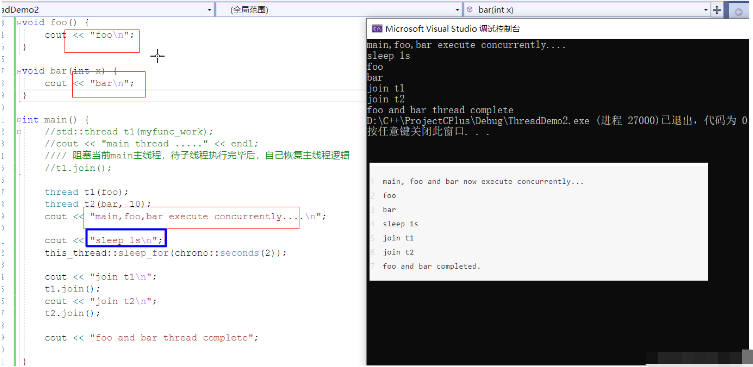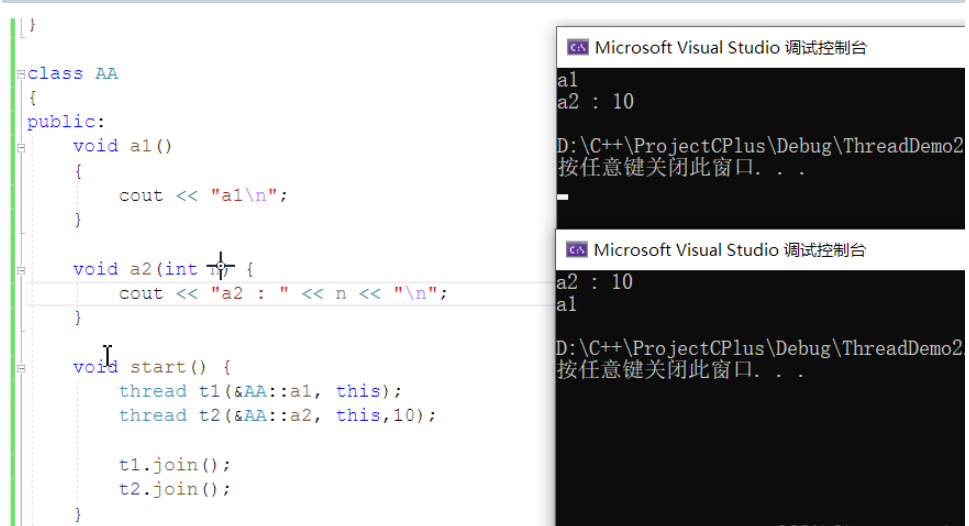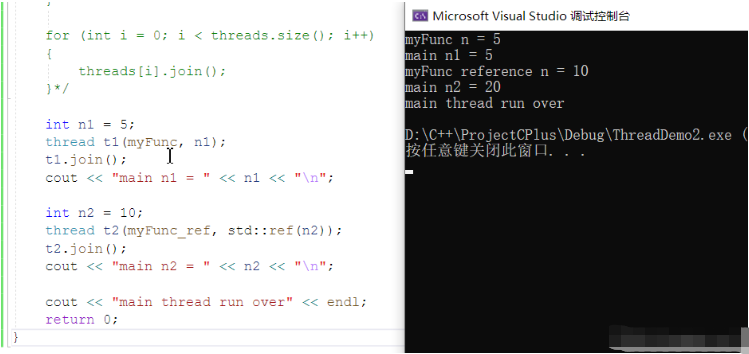本篇内容主要讲解“C++中std::thread线程怎么使用”,感兴趣的朋友不妨来看看。本文介绍的方法操作简单快捷,实用性强。下面就让小编来带大家学习“C++中std::thread线程怎么使用”吧!
最简单的 std::thread用法如下,调用 thread将立即同时开始执行这个新建立的线程,新线程的任务执行完毕之后, main()的主线程也会继续执行。
#include<iostream>
#include<thread>
#include<windows.h>
#include<string>
using namespace std;
void myfunc_work() {
cout << "myfunc_work ....." << endl;
// do something 5s
Sleep(5000);
}
int main() {
std::thread t1(myfunc_work);
// 阻塞当前main主线程,待子线程执行完毕后,自己恢复主线程逻辑
t1.join();
cout << "main thread ....." << endl;
}下面为C++ std::thread常用的成员函数
get_id() 取得目前的线程 id, 回传一个 std::thread::id 类型
joinable() 检查是否可 join
join() // 阻塞当前线程,等待子线程执行完毕
detach() // 与该线程分离,一旦该线程执行完后它所分配的资源就会被释放
native_handle() 取得平台原生的 native handle.
sleep_for() // 停止目前线程一段指定的时间
yield() // 暂时放弃CPU一段时间,让给其他线程
void foo() {
cout << "foo\n";
}
void bar(int x) {
cout << "bar\n";
}
int main() {
//std::thread t1(myfunc_work);
//cout << "main thread ....." << endl;
阻塞当前main主线程,待子线程执行完毕后,自己恢复主线程逻辑
//t1.join();
thread t1(foo);
thread t2(bar, 10);
cout << "main,foo,bar execute concurrently....\n";
cout << "sleep 1s\n";
this_thread::sleep_for(chrono::seconds(2));
cout << "join t1\n";
t1.join();
cout << "join t2\n";
t2.join();
cout << "foo and bar thread complete";
}
很显然:新线程建立后,是否立即执行新线程业务代码,有一定的随机性。
但是我们可以通过 thread.join() 或者 sleep_for() 来控制代码执行顺序
C++ std::thread 的构建可以传入class类别中的成员函数,如下范例所示:AA::start 分别建立t1, t2 两个线程,而 t1传入 AA::a1 类别函数。
notice :
第一个参数:AA::a1 前面需要添加 &
第二个参数:代表的是那个类对象
后面参数: 按照要求传入即可
class AA
{
public:
void a1()
{
cout << "a1\n";
}
void a2(int n) {
cout << "a2 : " << n << "\n";
}
void start() {
thread t1(&AA::a1, this);
thread t2(&AA::a2, this,10);
t1.join();
t2.join();
}
private:
};
std:: thread 的构建也可以传入 lambda expression 表达式,如下范例:
在main主线程建立 t1线程后,主线程便继续往下执行,如果主线程需要等待 t1执行完毕后才能继续执行的话,就需要使用 join 。
等待 t1线程执行完 foo 后主线程才能继续执行,如果 t1线程没有执行完,主线程会一致阻塞在 join这一行。
void test2() {
cout << "foo begin...." << endl;
this_thread::sleep_for(chrono::milliseconds(5000));
cout << "foo end...." << endl;
}
int main() {
std::thread t1(test2);
cout << "main 1....." << endl;;
t1.join();
cout << "main 2.....";
cout << "main thread run over" << endl;
}
承上例:如果主线程不想等或者可以不用等待 t1线程,可以使用 detach来让 t1线程分离,接着主线程就可以继续执行,t1线程 也在继续执行。
/**
join等待thread执行结束
*/
void test2() {
cout << "foo begin...." << endl;
this_thread::sleep_for(chrono::milliseconds(50));
cout << "foo end...." << endl;
}
int main() {
std::thread t1(test2);
cout << "main 1....." << endl;;
t1.detach();
cout << "main 2....."<< endl;
cout << "main thread run over" << endl;
Sleep(2000);
return 0;
}
定义方法:
void myFunc(int& n) {
std::cout << "myFunc n = " << n << endl;
n+= 10;
}使用参数传递使用引用目的是: 希望建立另外一个线程去执行 myFunc , 之后需要取得这个 myFunc的运算结果,但是建立线程如果写: std::thread t1(myFunc , n) 这样会编译出错。
因为在 std::thread 的参数传递方式为值传递,值传递是不可修改的左值,如果要让其能修改,可以考虑通过 : std::ref 来达成。
void myFunc(int n) {
std::cout << "myFunc n = " << n << endl;
n += 10;
}
void myFunc_ref(int& n) {
std::cout << "myFunc reference n = " << n << endl;
n += 10;
}
int main() {
int n1 = 5;
thread t1(myFunc, n1);
t1.join();
cout << "main n1 = " << n1 << "\n";
int n2 = 10;
thread t2(myFunc_ref, std::ref(n2));
t2.join();
cout << "main n2 = " << n2 << "\n";
cout << "main thread run over" << endl;
return 0;
}
到此,相信大家对“C++中std::thread线程怎么使用”有了更深的了解,不妨来实际操作一番吧!这里是亿速云网站,更多相关内容可以进入相关频道进行查询,关注我们,继续学习!
亿速云「云服务器」,即开即用、新一代英特尔至强铂金CPU、三副本存储NVMe SSD云盘,价格低至29元/月。点击查看>>
免责声明:本站发布的内容(图片、视频和文字)以原创、转载和分享为主,文章观点不代表本网站立场,如果涉及侵权请联系站长邮箱:is@yisu.com进行举报,并提供相关证据,一经查实,将立刻删除涉嫌侵权内容。